Zenkaikon 2014: The Panels
The meh, the eh?, and the ZOMFG.
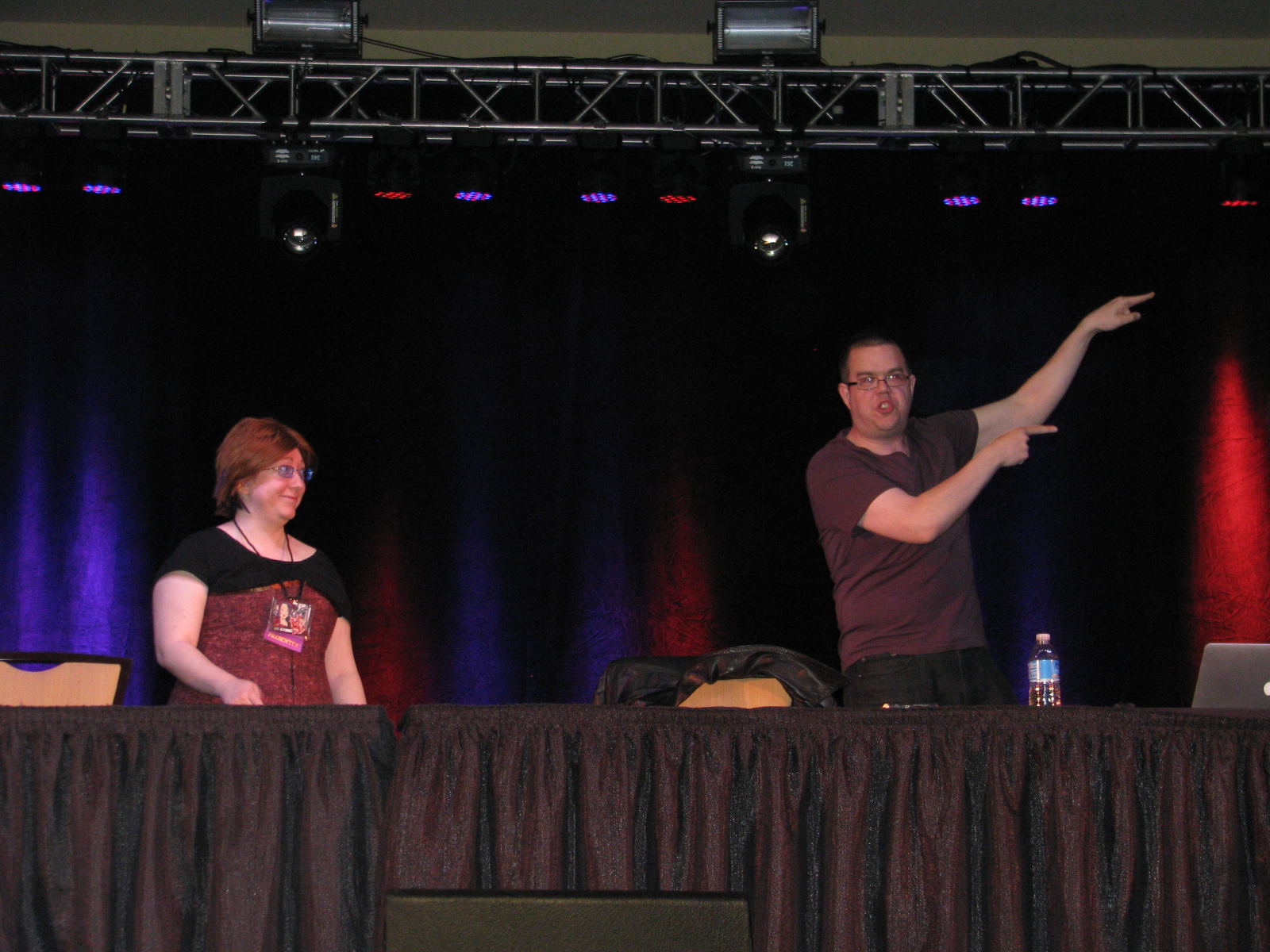 Zenkaikon’s always managed to pull together some great panel content. This year’s featured panelists Charles Dunbar and GeekNights certainly made the selection sparkle, but there were other panelists on hand who also offered up presentations that varied from promising to thoroughly enjoyable. Apologies for the long and long awaited post, but I like to give credit where credit is due and suggestions wherever possible. I thank all panelists for their courage and efforts in bringing content of all kinds to Zenkaikon so that it can be that much better and all the more inclusive. Panel breakdown after the break:
Zenkaikon’s always managed to pull together some great panel content. This year’s featured panelists Charles Dunbar and GeekNights certainly made the selection sparkle, but there were other panelists on hand who also offered up presentations that varied from promising to thoroughly enjoyable. Apologies for the long and long awaited post, but I like to give credit where credit is due and suggestions wherever possible. I thank all panelists for their courage and efforts in bringing content of all kinds to Zenkaikon so that it can be that much better and all the more inclusive. Panel breakdown after the break:
 Hidden Gems of Manga
Hidden Gems of Manga
Always attend this type of panel. Exposure via word of mouth is largely responsible for building the fandom base and expanding the horizons of those who feel they don’t know how to go about finding more of what they like. Presenter Brady, for her selection, used MAL (My Anime List) titles with under 3,000 readers and then threw in some personal recommendations as well. This was an interesting approach, as MAL doesn’t run on purchases—just fans logging what they’ve read. For each title (a list of most titles recommended follows this writeup), Brady discussed plot briefly and noted publisher and publication status as well as the interesting/defining aspects. Sporadically, she also gave some reading suggestions based on similar themes. There was a wide range of genres and sub-genres covered within the hour, and when her list was exhausted, the presenter threw in a few ways those interested could discover recommendations on their own: online sites, brick and mortar stores, etc.
The recommendations: Even a Monkey can Draw Manga (Koji Aihara), Twin Spica (Kou Yaginuma), Ooku the Inner Chambers (Fumi Yoshinaga), Towards the Terra (Keiko Takemiya), Heart of Thomas (Moto Hagio), Eagle: Making of an Asian-American President (Kaiji Kawaguchi), Genkaku Picasso (Usamaru Furuya), Banana Fish (Akimi Yoshida), Tokyo Zombie (Yusaku Hanakuma), Ode to Kirihito (Osamu Tezuka), Tropic of the Sea (Satoshi Kon), and “any title by Juko Mizuno.”
 Real Robots: Crushing your misconceptions
Real Robots: Crushing your misconceptions
I’m not a fan of mecha/Gundam, but the title of this panel sounded promising; I deal with real robots a lot in my day job and was eager to see how the presenters were going to tie fiction to reality. Unfortunately, my imagination proved more interesting than the actual purpose of the presentation, which was more focused on dispelling misconceptions about robot anime: simple good vs. evil tales, total lack of depth, that they’re nothing but explosions, that all robots are “hyperidiculously” powerful, etc. Conceived of for the purpose of “raising robot awareness,” the presenters springboarded off of audience associations to define and contrast Super Robots and Real(istic) Robots in anime and then examine examples of each in various series. While disappointing in comparison to what I’d expected, the panel was also a tad too on the squeeish side; a lot of “examples” boiled down to claiming a series to be exceptional but never explaining why in a solid manner. Crowd control was also an issue; often the audience would get sidetracked on minutia, and the panelist would just roll with it. Another issue I took was the selection of titles used for examples. I’m in no way an authority on what titles are out there, much less which ones are good or not, but even I know the proverbial surface was barely scratched.
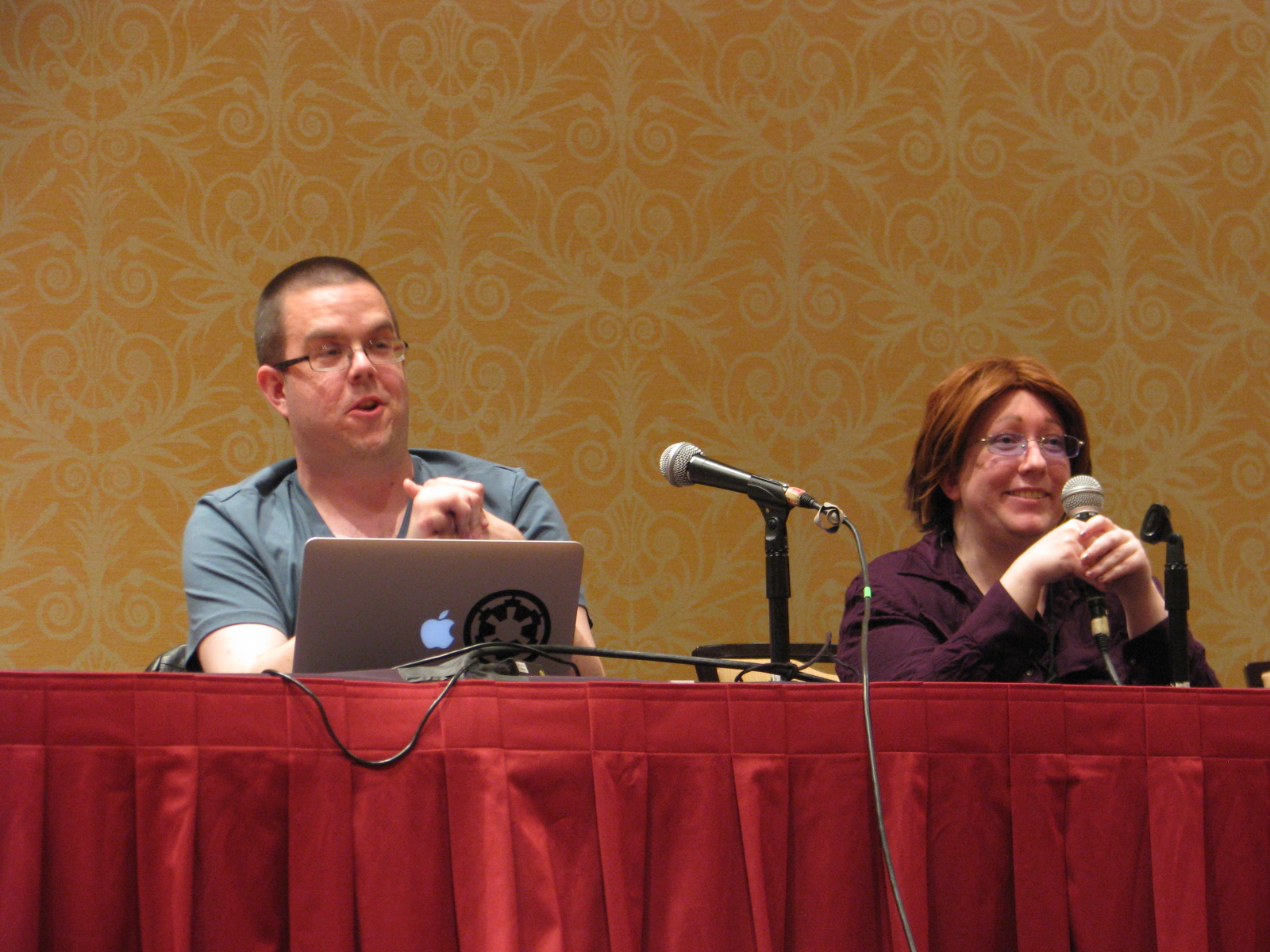 An Otaku Culture Panel
An Otaku Culture Panel
This is the kind of topic which makes featured panelist Charles Dunbar (accompanied by Katriel Page) tick. While much drier than his explorations into myth, folklore, and history, this examination of otaku in both Eastern and Western cultures was nonetheless driven and therefore compelling. The presenters fluidly tied together such topics as looking at images of national and personal identification; how networks are leveraged, how they affect values, and how they come to define differentiation; use of technology; concerns of dilution and dilatantism within fandom; sterotypes; activites … you get the point. True to the nature of both presenters, every section, every point, was back up by concrete facts and examples bolstered further by quotes from established authors and experts. Digging into community to define it is Dunbar’s bag, and this panel gives some great insight into just how objective and obsessive his approach is.
 Disney Afternoon: 20 Years Later
Disney Afternoon: 20 Years Later
Uncle Yo interviewed voice actor Jim Cummings by running through the classic cartoons with which he was involved. This was one part nostalgia and one part reminder of what worked, what didn’t, and why — with industry insider information peppered throughout. A nigh perpetual laughtrack was inevitable given the tomfoolery induced by Yo’s questions and Cummings’ vocal talents, wit, and commentary. Given the range of characters he’s done, it was amazing to hear Cummings fall with seeming effortlessness into just about any of his past roles at the drop of a hat. Some of the more standout moments included Cummings, in the voice of Don Karnage from Disney’s Tailspin, running through the French castle scene from Monty Python and the Holy Grail with Uncle Yo; Cummings reading a list of “updated” Darkwing Duck intros prepared by Uncle Yo; and Cummings reading a Hannibal Lecter monolog as Disney’s infamous ne’er-do-well Pete.
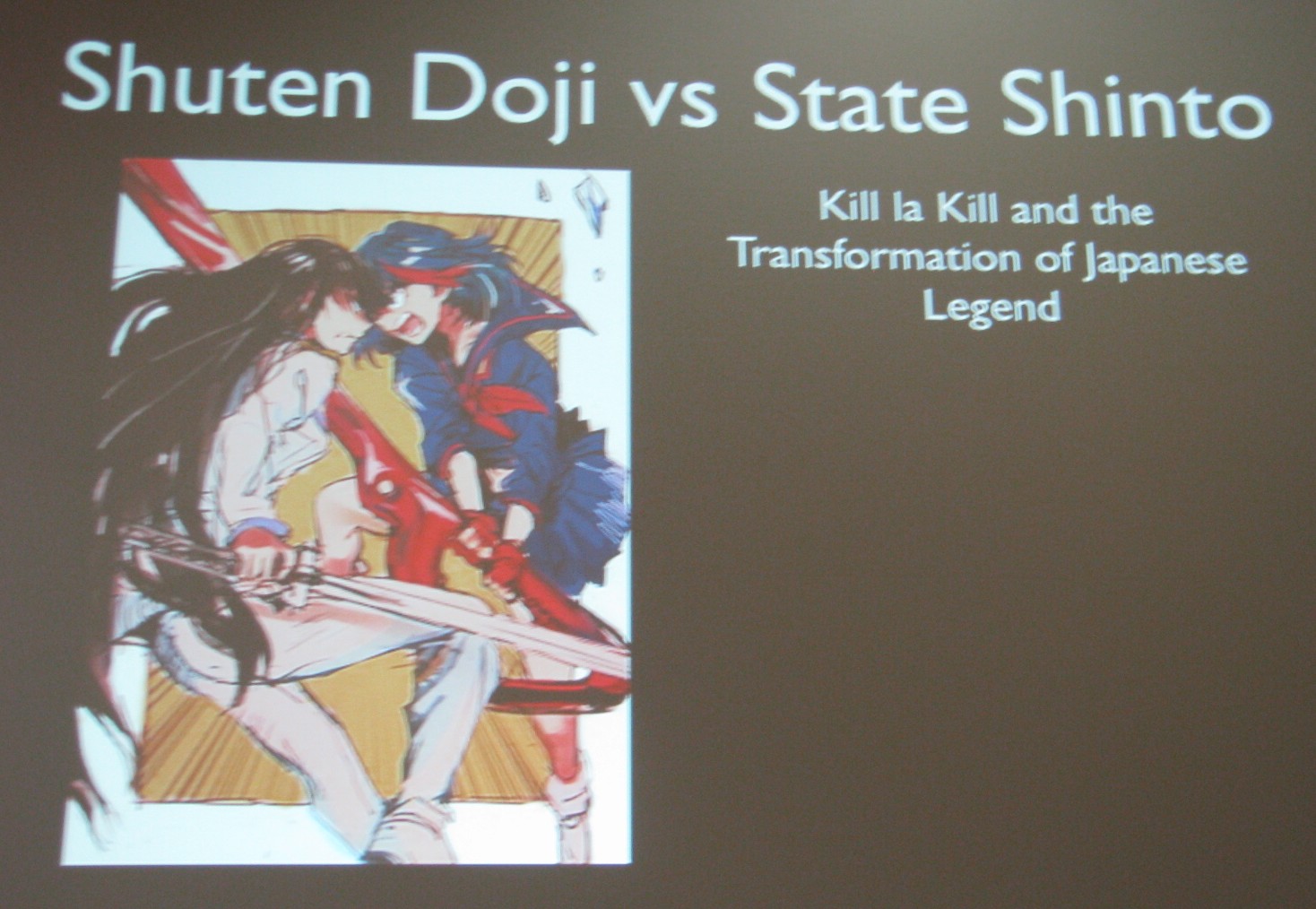 Kill La Kill and the Transformation of the Japanese Legend
Kill La Kill and the Transformation of the Japanese Legend
Combine a translator/ researcher and an anthropologist with a superiorly structured break-down of a highly layered and complex anime that begs for analysis, and you have this powerhouse panel. The combination of Charles Dunbar and Katriel Page makes complete sense given both presenters’ posts on Study of Anime on various topics inspired by the Trigger series Kill La Kill, but this panel is truly their best collaboration. Scripted handoffs rather than interruptions of inspirations lent an air of authority to whomever was speaking or being nudged to speak. That there was so much information to cover and the two presenters covered it almost seamlessly speaks not only to how closely they’ve worked on the presentation but how deeply they’ve dug into the requisite source materials. One down side: this was held in the largest room of the con (Main Events), and for something so intricate, it would have been nice to be able to hear all of it. In the front row, everything was just audible, but I have a hard time believing those in the back heard some of the nuances that were so necessary to the enthralling flow of the presentation since the first half of the presentation went sans mic. I’ve heard Dunbar’s trying to give this panel at all cons he attends, so check it out if it comes around … especially is Ms. Page is accompanying.
 All Anime are the Same
All Anime are the Same
Rym and Scott of GeekNights are somewhat notorious for giving panels misleading names. So what seemed like it was going to be a dismissive panel about the banality of a medium actually turned out to be an examination of the formula behind the phenomenon known as the standalone, in-/post-series, summer movie OVA. The presenters kept cycling through three example OVAs from the Lupin III, Slayers, and One Piece properties to illustrate the universal, underlying formula they (and all of their kind) share. These include how characters, existing and new, are introduced as well as to what degree they’re featured (and why); their “island” setting; the bad guy hierarchy; the “Square Boss” (the big bad); and the rationale behind the fate of all characters involved. All representative examples were well timed and trimmed and illustrated the painfully obvious. During these, color commentary created an atmosphere with just the right amount of snark and humor to force a disconnect with the material for the sake of inducing objectivity. I’d highly recommend going to see this if it comes to a con near you. It’s one of those panels that, after taking in its lesson, makes you incapable of ever watching something the same way again.
 The Sengoku Era, Basara, You, & Awesome
The Sengoku Era, Basara, You, & Awesome
I went into this panel expecting to take away something substantial about Sengoku Basara’s use of and divergence from the history upon which it is based but was greeted by a fangasm mission statement. Since those two things aren’t necessarily mutually exclusive (and I honestly had no idea Sengoku Basara was a game as well as an anime), I sat at the ready to learn whatever there was to learn. The presenter covered news, info, merch, games, and the anime, all in brief. The speedy section on history was given to provide some sense of plot and was later followed later by a slightly more in-depth, character-by-character relationship section. It was never quite clear, since I’m horrible with remembering names and dates, whether or not the characters were accurate to history or their relationships were strictly in-game/-series. Although I wasn’t this panel’s target audience, the panelist’s efforts was not lost on me. There’s great potential if she wants to take it one step further, from fangasm to a historical examination. Ways to do this might include pointing out specific elements of interest during extended clips and more comparing and contrasting of fact and fiction.
Big Bads: A Look at the Mythical Adversary
It’s not always so easy being an all-powerful deity. Your actions can be misinterpreted, your name can be dragged through the mud via some unrelated grudge, or … you might actually be the bringer of all-doom. For this panel, Charles Dunbar presented a slideshow which offered a chance to look at villains in a different light through use of history and culture. Therein he explores some dominant deity-defining roles—godlike, rivals, shadow, devil (anti-conscience)—and examples of those who’ve filled them accompanied by their features and methods. As a chronology of feared gods from cultures worldwide, Dunbar gave basic definitions, origin stories, and examples of lore (both mythical and popular) via a slideshow with callbacks to anime and video games wherever possible. It’s a fun panel with interesting facts and, due to the delivery, a lot of laughs.
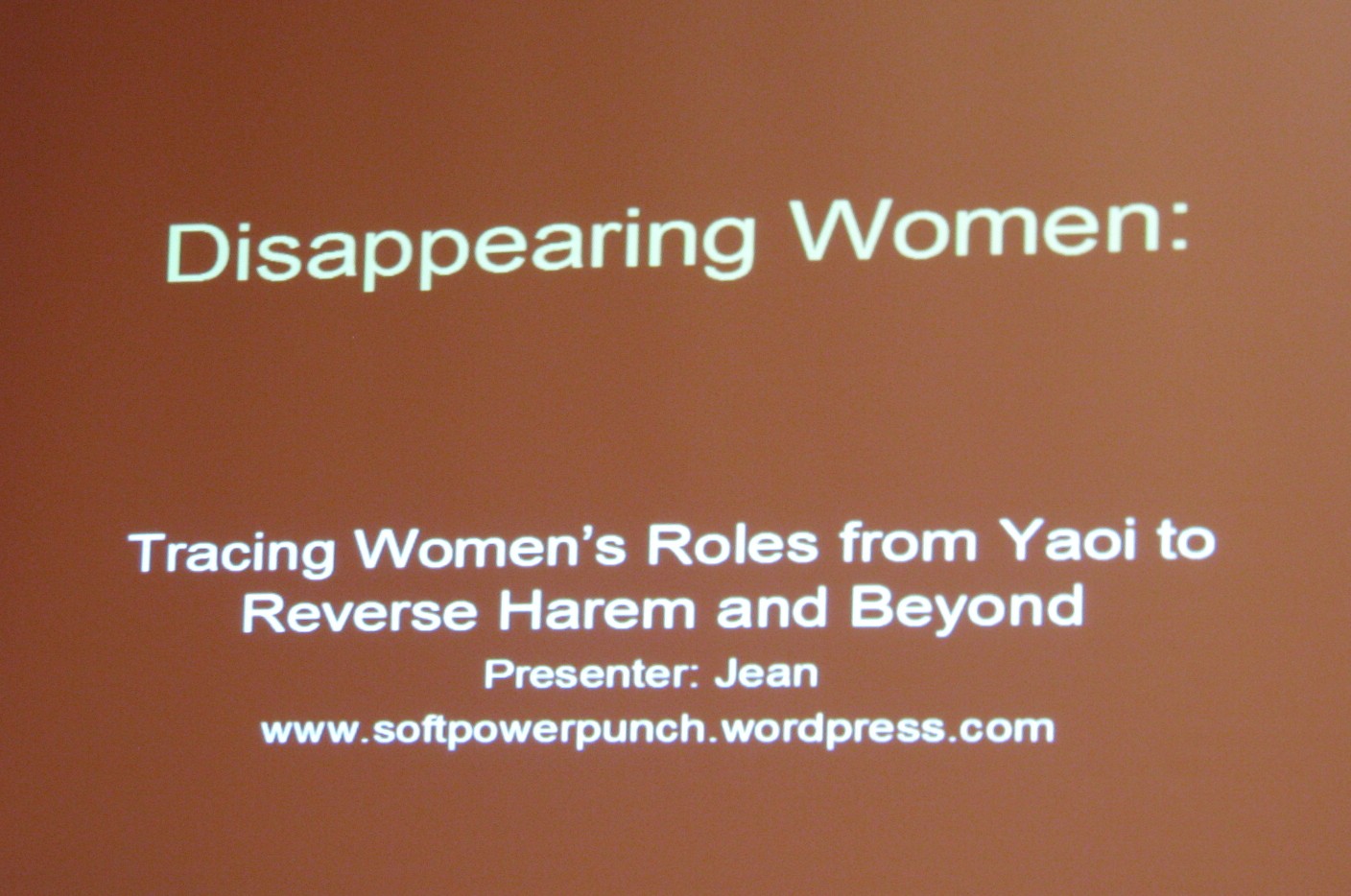 Disappearing Women: Tracing Women’s Roles from Yaoi to Reverse Harem and Beyond
Disappearing Women: Tracing Women’s Roles from Yaoi to Reverse Harem and Beyond
The panelist was definitely credentialed to talk about the subject, being an “international analyst w/focus on transnational cultural exchange,” and many kudos are due her for the disclaimer on talking about Japanese culture from the perspective of an outsider. The focus was on TV-based media (anime, J-drama), as well as manga, made by women for a female audience. The strength in her panel showed in her examination of “imbalanced women,” those who struggle to find balance between home and work; the feminine body and masculine physique (crossdressing); and gender displacement (yaoi). Unfortunately, she kept asking the audience to summarize shows used for examples, which slowed the panel to a stuttered crawl, and had a tendency to fall back on and overuse the trite “strong female character” descriptor without citing specific examples in most instances. While the three categories of how women are often represented in media seemed right on track, little was done to connect the concept with the culture. Prior to this panel, I discussed its title with a friend, who offered up some history on the subject. I would’ve liked to have seen such insight from the panel, but it unfortunately veered into a lightly moderated, audience-led rant on lack of acceptance in current times. While that’s a fine topic, and could be relevant to the discussion, it was never tied in proper. This could be a great panel with more elbow grease and less audience participation.
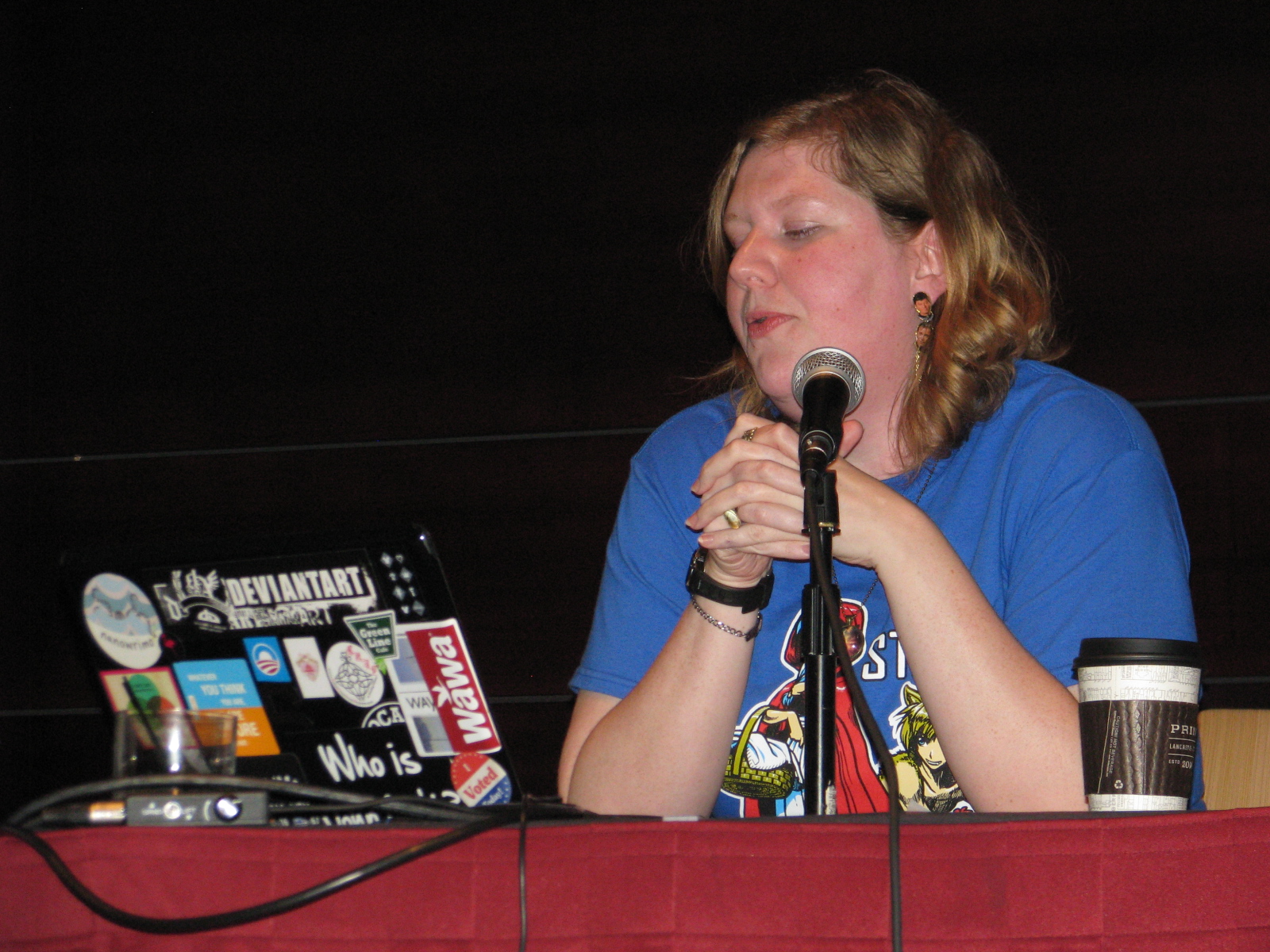 Combating Otaku Stigma, Or Why We Will Rule the World
Combating Otaku Stigma, Or Why We Will Rule the World
After defining “otaku” with and for the room, the panelist sought to help those in the audience develop a diplomatic discourse for defending fandom. Oddly enough, this picked up exactly where Dunbar’s Otaku Culture panel left off, on the topic of how “not being able to defend yourself hurts the community.” To that effect, she stressed specificity with regards to explaining the content of whatever is being read/watched/played/worn. Mention was also made to the historical trend of a conservative art culture that pushes back against new art forms. Along with the notion of otaku as “third culture children” benefitting from increased communication opportunities stemming from diverse interests (having international experiences without leaving the USA), the panel stressed maintaining a healthy relationship with one’s hobby: consuming media without letting it consume the hobbyist, to actively create and avoid becoming complaisant. I liked this panel a great deal, because instead of just mulling over what otaku means to those who innovated and appropriated the term, the panel was about proactively dealing with the negative preconceptions of others in an intelligent and empowering manner.
